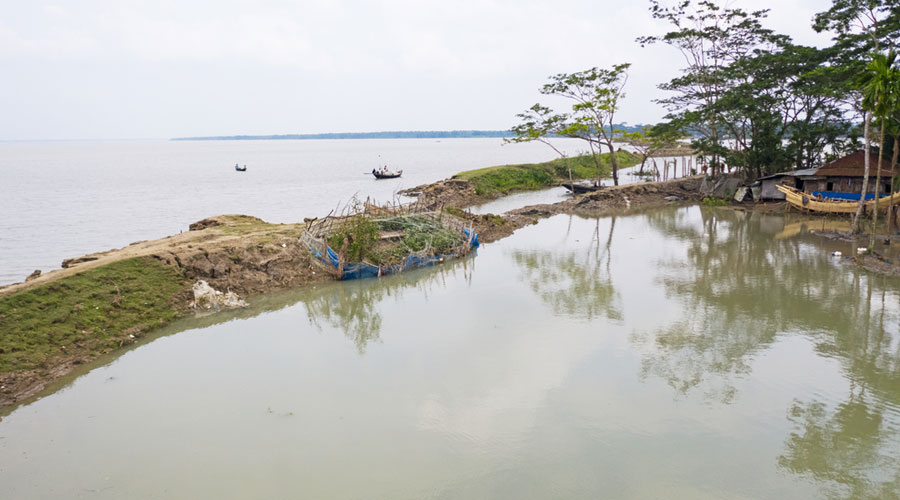The sea-level rise in the Bay of Bengal, off the eastern coastline of India, over the past three decades is the second highest in the continent with nearly 30 per cent higher rise than the global average, a report released by the World Meteorological Organization (WMO) at Bangkok on Tuesday has revealed.
The report titled The State of the Climate in Asia 2023 also highlights that the rise of temperature in West Bengal and adjoining Bihar-Jharkhand belt was the highest in the country alongside some northern states.
Asia has been marked as the world’s most disaster-prone region in 2023 with flooding causing the highest number of casualties and economic losses, with the impact of heatwaves becoming more severe.
“Many countries in the region experienced their hottest year on record in 2023, along with a barrage of extreme conditions, from droughts and heatwaves to floods and storms. Climate change exacerbated the frequency and severity of such events…,” WMO secretary-general Celeste Saulo has pointed out in the report; which has been co-partnered by the Economic and Social Commission for Asia and the Pacific (ESCAP).
“The findings say it all, I have nothing to add,” said Mrutyunjay Mohapatra, director-general of meteorology in India Meteorological Department (IMD) and also a vice-president of WMO; when asked about India’s vulnerability.
Global climate expert Harjeet Singh said the report “emphasises the need for robust climate finance mechanisms to scale up adaptation and address loss and damage in developing countries of Asia that bear the brunt of climate related adversaries”.
West Bengal, a climate hotspot
“In India, severe heatwaves in April and June resulted in about 110 reported fatalities owing to heatstroke. A major and prolonged heatwave affected much of Southeast Asia in April and May, extending as far west as Bangladesh and eastern India …with record-breaking temperatures,” states the report.
A close look at the report shows that the average temperature in 2023, compared to the average of 1991-2021, increased in the range of 0.5 to 1 degree Celsius in the eastern India, especially almost whole of West Bengal, part of Jharkhand, Bihar and the northern states like Uttarakhand, Uttar Pradesh, Himachal Pradesh, Delhi, Rajasthan, Jammu and Kashmir, Ladakh and Punjab.
The sea-level rise, considering the period from January 1993 to May 2023 as calculated through satellite measurements, was found to be 4.44mm per year in Bay of Bengal off the West Bengal coast, about 30 per cent higher than global average of 3.4mm during the period; and only second to western tropical Pacific region which rose at a level of 4.53mm per year. The Sunderbans, off the coast in West Bengal, has been found to have the highest sea-level rise in the country as intimated by the central government in Parliament sometime ago.
“The data tallies broadly with our finding but several factors often play in tandem to push relative sea level rise around 12mm in the Sunderbans; impacting a large populace,” said Sugata Hazra, professor of Oceanography at Jadavpur University.
“If Dubai, a city synonymous with state-of-the-art infrastructure, struggles to cope with disasters as we saw recently during an unprecedented downpour; how can we expect the impoverished and underprepared communities in the Sunderbans to withstand the cascading impacts of climate change?” asked Harjeet Singh, adding that the report should act as a wake-up call not only to the state and national governments in India but also to the world.
“The cost of inaction will be very high for climate impacted communities in Sunderbans and likewise,” added the expert.
Soaring Celsius, melting glaciers and killer floods

The report linked the high intensity of flooding in 2023 with record-breaking sudden rainfall triggered by cyclones impacting the region File photograph
“The annual mean near-surface temperature over Asia in 2023 was the second highest on record, 0.91°C … above the 1991–2020 average and 1.87 °C … above the 1961–1990 average. Particularly high average temperatures were recorded from western Siberia to central Asia and from eastern China to Japan,” reads the report.
Even the sea was not spared with sea surface temperature being found to shoot up in various Asian sea regions at a rate being more than three times faster than the globally averaged sea surface temperature.
Marine heatwaves, prolonged periods of extreme heat in the ocean, had occurred in a large area of the Arctic Ocean, in the eastern Arabian Sea and the Northern Pacific, and lasted three to five months.
“Due to emission of heat-trapping greenhouse gases resulting from human activities, the global ocean has warmed. It has taken up more than 90 per cent of the excess heat in the climate system … also indirectly alters storm tracks …” explains the report.
“The heatwave and its impact on water resources will increase manifold in the near future. The shrinking water resources can lead to conflict situations within a country endangering national security,” Sanjay Vashist, director of Climate Action Network South Asia (Cansa), told this reporter.
In 2023, the precipitation was below normal in almost throughout the entire Asian region including the Himalayas, around the Ganga and lower course of the Brahmaputra rivers; in both India and Bangladesh.
However, despite overall less precipitation, over 80 per cent of reported hydro-meteorological hazards in Asia were flood and storm events in 2023, leading to more than 2,000 fatalities and directly affecting nine million people, including India, confirms the report.
The report linked the high intensity of flooding in 2023 with record-breaking sudden rainfall triggered by cyclones impacting the region; and referred to the severe cyclonic storm Mocha in the context which barely bypassed West Bengal and significantly damaged Myanmar and Bangladesh.
